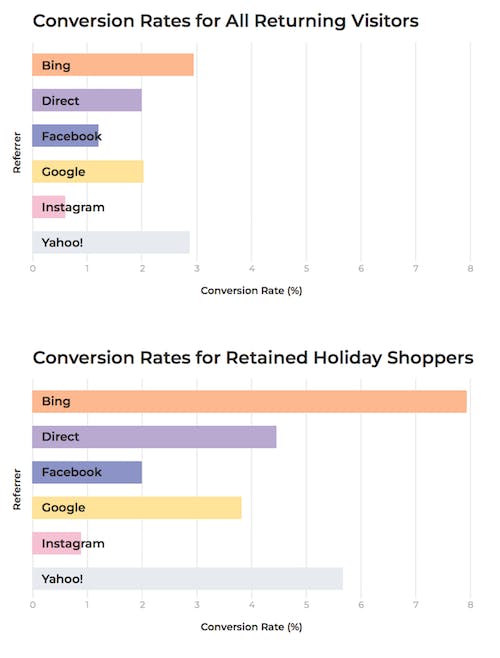As retailers gear up for the 2019 holiday shopping season, research published by personalization software vendor Monetate suggests that they would be wise to make an effort to target customers who converted during the 2018 holiday shopping season.
The company looked at more than 8.5m customers who were acquired during the 2017 holiday shopping season and found that when the 2018 holidays rolled around, they converted at a substantially higher rate than all returning customers. Specifically, Monetate found that all returning customers converted at a 2% clip whereas returning customers who converted during the 2017 holiday shopping season converted at a 4.2% clip.
“In other words, people who bought something over the past holidays are more than twice as valuable as people who bought something at any other time of year,” Monetate commented. As such, retailers could benefit by strategically targeting this customer segment.
Monetate’s findings also suggest that retailers could benefit by segmenting returning holiday shoppers even more granularly by referral source. For example, it found that customers who were acquired through Bing and Yahoo consistently converted at high rates — 5% and more than 4%, respectively — substantially higher than customers acquired through Google, who converted at less than 3%.

While customers acquired via referrals from Facebook and Instagram converted at rates even lower than Google they represented the fastest-growing channels. Conversions from Facebook and Instagram grew by over 70% and nearly 40%, respectively.
Can a segment be too small?
Monetate’s research highlights the fact that smart, granular segmentation has the potential to help retailers increase conversions during the most important period of the year. And Monetate has simple advice for retailers: “Don’t allow the size of a segment deter you from building more best customers.”
Following this advice in the real world, however, is likely to be challenging for many retailers.
While Bing-sourced retained holiday customers were seen to convert at a rate approximately one and a half times higher than Google-sourced retained holiday customers, for instance, Bing and Yahoo combined made up just 2% of all holiday visitor traffic Monetate tracked in 2018. The company advises that marketers shouldn’t leave Bing and Yahoo out of campaign planning despite the comparatively small amount of traffic they drive, but it’s likely that some if not many retailers won’t see the value of creating small customer segments when the costs, such as management overhead, are taken into consideration.
But this shouldn’t be the end of the story. Instead, the fact that smaller customer segments have the potential to significantly outperform is a reminder to retailers of the importance of arming their marketing teams with robust tech and data capabilities.
Given the right tools and know-how, marketers can identify high-value customer segments, model the economics of targeting them, and execute targeted campaigns as efficiently as possible — sometimes in automated or semi-automated fashions. In addition, in many cases, retailers will also be able to ensure that marketing spend is allocated wisely with the goal of growing these high-value customer segments so that they’re no longer small in size or revenue.
